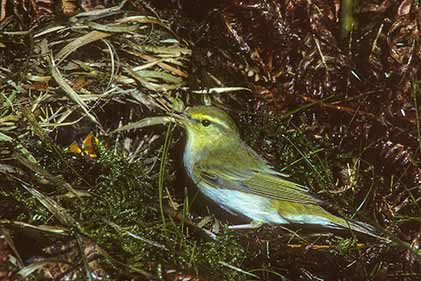Wood warbler (Phylloscopus sibilatrix)
When: From late April to early September
How many: Moderate numbers

Whilst not exactly rare in the New Forest, the wood warbler is one of those birds that it’s always good to see, a creature whose presence never fails to brighten even the dullest day.
As the name suggests, wood warblers are woodland inhabitants, most at home amongst broad-leaved trees and, in particular, the mighty oaks and beeches of the New Forest’s ancient, unenclosed woodlands. Wood warblers do, though, also like areas of invading birch, but usually in what have been woodland clearings rather than at the woodland edge.
Spring and summer visitors, wood warblers arrive in the New Forest in late April or early May, and generally depart by early September. They are quite well-built, even stocky birds, although in size are slightly smaller than a robin.
Resplendent in cloak of bright yellow, green and buff, wood warblers are by far the brightest of Britain’s ‘leaf-warblers’, considerably more so than the closely related chiffchaff and willow warbler.
But when in the canopy, wood warblers can be incredibly difficult to see, and are often best located by listening for their beautifully distinctive song, or to be more precise, songs, for two versions are heard, sometimes one after the other, sometimes completely separately.
The first is a series of soft, almost indrawn, piping notes, whilst the second, given with quivering, throbbing throat, is a quietly insistent tremulous trill, starting slowly then gathering pace to finish with a flourish.
Song is the province of the male, and is most pronounced early in the breeding season when territories are being established, mates attracted and the pair bond strengthened. Later on, with maybe half-a-dozen hungry mouths to feed, there’s little time or need to advertise, so then the birds fall silent.
Wood warbler distribution mirrors their rather specific habitat requirements, which, in essence, are broad-leaved woodlands with sparse ground-cover. The oak woods of Dartmoor, Exmoor, Wales, parts of the Pennines, the Lake District and Scotland are ideal for Wood warblers - the soil is poor and grazing by sheep further suppresses ground cover. In the New Forest, similarly poor, acidic soil and grazing by commoners’ stock, and deer maintains the open woodlands in suitable condition.
Wood warbler habitat requirements are, in fact, very similar to those of the redstart, but for different reasons. Wood warblers find their tiny insect food amongst the canopy, but prefer relatively open areas of woodland floor on which to build their robust, domed nests. Redstarts, in contrast, like mature broad-leaves in which to find a nest cavity, with fairly open ground below on which to hunt.
Somewhat oddly, though, wood warblers in the New Forest have in recent years substantially reduced in numbers, whilst redstarts have done well.
Between 1980-83, wood warbler population estimates suggested around 450 territorial males, whilst in the mid/late-1970s it was estimated that around the same number of redstarts were present. Now, despite wood warbler numbers being prone to annual fluctuations, redstarts seem consistently to outnumber them by at least 20:1, and probably more.
The local fortunes of the wood warbler are also mirrored nationally and, indeed, across much of northern and western Europe. Modest declines were reported up to 1994 after which decline has accelerated – results from the British Trust for Ornithology’s (BTO) Breeding Bird Survey (BBS) suggest by around 65%.
But for now, let’s be grateful for the wood warbler's continued presence in the New Forest, and always eagerly look forward to those distinctive sounds of May.
References:
Collins Bird Guide: Killian Mullarney, Lars Svensson, Dan Zetterstrom and Peter J.Grant
Birds of Hampshire: Hampshire Ornithological Society
Hampshire Bird Reports: Hampshire Ornithological Society
The Birds of the Western Palearctic, Concise Edition: D.W. Snow and C.M. Perrins
The New Atlas of Breeding Birds in Britain and Ireland (1988-91): D.W. Gibbons, J.B. Reid and R.A. Chapman
The Migration Atlas: British Trust for Ornithology
More links
Other related links
Search this site

Sadly, 58 animals were killed - 35 ponies, 13 cows, 8 donkeys and 2 sheep, whilst a further 32 were injured - 3 pigs, 9 donkeys, 11 cows and 9 ponies.
(Forty-three accidents occurred in daylight, 15 at twilight and 101 in the dark. Twenty-seven accidents were not reported by the driver involved).
Here's just one horrific example - Three donkeys killed in collision with van at notorious New Forest blackspot (Advertiser and Times)

